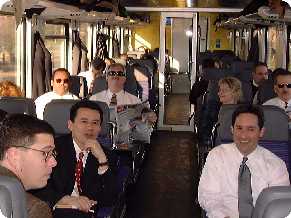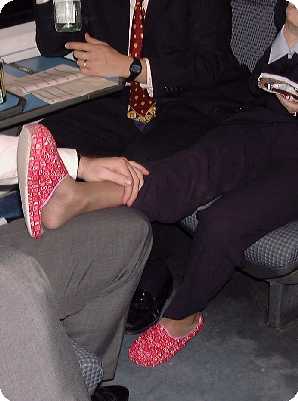

Executive Fellows - Class of 2001
Day 4 March 6th 2000
What happened on day 4
Day 1 – The Munich Railroad Marathon
Trip to
Siemens AG, Munich, GermanyAt 6:45 GMT+1, we departed the Marriott Zurich Hotel for a short walk to the Zurich train station with a bag of breakfast and a spring in our step. After boarding the train we set out for Munich and the corporate home of Siemens AG at about 7:33 GMT+1. Our train ride (of four and a half-hours) featured clear skies, a blazing sun and views of quaint countryside villages. It seems that everyone has a small plot of ground tilled for gardening and indeed, the area contiguous to the railroad tracks was dotted with small sheds, raised plots and meticulously staked rectangles for home gardens. We noticed as we passed from Zurich into Germany that the structures changed from very colorful Swiss to dull and dreary.
Both the vineyards and elevation increased as we got closer to Germany. As we crossed the border into Germany from Switzerland, two heavily armed soldiers with a snarling German Shepherd walked through the train, asking for passports. They passed our group fairly quickly, and we observed them just down the car going through the belongings of another passenger with Fido at rapt attention.
We arrived in Munich at 11:30 GMT+1 and took a short bus ride through the city to make our noon appointment at Siemens AG. We were greeted by Dr. Hartmut Runge, who took us to the fourth floor conference room. Dr. Runge gave us an overview of the company as we helped ourselves to complementary beverages; the most popular of which appeared to be Schwartz café.
Siemens AG is a world leader in electrical engineering & electronics with a comprehensive product range producing everything from mobile phones to power plants. Only telephones and computers are produced by Siemens for the personal consumer – everything else is "B2B". The visit was arranged by one of our fellows who is a KCP&L employee — Duane Locke.
German infrastructure systems account for 80% of Siemens’ business. Net sales approach DM $135 billion. They currently have 570,000 shareholders, which Dr. Runge noted is an unusually high number of shareholders in Europe and provides the advantage of protecting from hostile takeovers through a diverse shareholder group.
Siemens has over 400,000 employees in over 190 countries and, like Coca-Cola, is in more countries than are members of the United Nations. Siemens plans on being listed on the NYSE in 2001 – it will be in the top 100 companies on the exchange; it is currently traded only in Germany and England. Part of their strategy is to acquire U.S. companies. Siemens believes one must be listed on a U.S. exchange since acquisitions are by stock more so today than cash.
The following is the current distribution of worldwide sales for Siemens Corp:
|
Regional area |
1999 |
Goal |
|
Germany |
27% |
25% |
|
Europe |
31% |
25% |
|
Americas |
25% |
25% |
|
Asia, Africa, Middle East |
17% |
25% |
US employment (60,000 employees) and China (30,000 employees) are growing the fastest at this point.
Local subsidiaries are run as local companies and contain very few Siemens employees; however, almost all Siemens subsidiaries have a German controller.
|
Country of Employment |
Percentage |
|
Germany |
43% |
|
Europe |
25% |
|
Americas |
21% |
|
Asia, Africa, Middle East |
11% |
After WWI and WWII, Siemens lost all patents and property. Siemens has since actually "restarted" three times—Siemens’ people came back from the war well-trained, determined and trained, and since all machinery was confiscated by the Allies, established new technology each time.
The Siemens Visitors Center uses aggressive internal marketing techniques—the state-of-the-art visitors’ and conference center is used, among other things, for recruit tours in an effort to attract upcoming college graduates.
Dr. Hartmut was kind enough to answer very in-depth questions about the German Retirement System. It is quite different than that of the U.S. In Germany, WWII wiped out pension funds, so they created "The Generation Treaty"–a principle to bridge retirement between working people and the retirement generation. There is currently only a three-month reserve, and the older generation is growing while birth rates are plummeting, causing the working generation to now pay 20% of wages into the retirement fund.
Taxes are very high — $100K/yr income is taxed at a 56% rate. In addition, a 5% additional tax is now levied for the reconstruction of Eastern Germany. In addition, the average German citizen pays retirement fees, unemployment insurance, and denomination (church) tax. In the aggregate, this amounts to over 65% in income tax and related assessments. Compared to the English, the Germans pay approximately twice as much but, as Dr. Hartmut says, "It’s a great nuisance to see all that money go to the state. The real challenge in the
European Union is to bring value-added systems (social security, et. al.) into harmony – it takes a generation, at a minimum, to unify this effort."
Marketing and cultural differences between the U.S. and Germany are little. US does have a huge, uniform market. The European market is not as uniform; for instance, as simple as the challenge may seem the electrical and phone plug systems will never be unified. Germany does have some inherent advantages including the fact that early cell phone networks had to cross boundaries within small countries in Europe, creating a demand to adapt to multiple standards and technologies.
Siemens management structure is extremely decentralized. Each group is responsible for its own business, R&D, marketing, products, recycling, etc. Siemens is a matrixed organization—95% of R&D is in the groups, 5% is centralized (on issues that don’t fit an individual operating group). All groups have "component centers" where technology is clustered; i.e. all waterpower is located in Brazil, all cancer research is in Chicago.
Currently the lighting group (Sylvania/Osram) is the most profitable and all groups are in the black. Siemens shares have quadrupled in the past three years. The current share price is 190 Euros.
Revenue per employee at Siemens is not as high as more service-oriented companies (Dr. Hartmut often uses "turnover per person" rather than revenue per person). The long run goal of Siemens is to be 50% "real products"/ 50% "services" (versus a current ratio of 75/25). Siemens recognizes that services use less capital with higher margins than does product output. Siemens employees currently own approximately 8% of outstanding shares with no majority shareholder. The Siemens family (200 people) own only 7% of company shares today.
Siemens stock options are offered after 7 years, and mostly at higher management levels –much like America. Siemens in Germany is currently short over 70,000 people in I.T. positions. They feel very threatened because of shortage of I.T. Germany currently has so little land and there are such strict immigration laws that Germany is now discussing a "green card" system to fill I.T. needs, in spite of worsening crowding of this small country.
Germans are not like Americans – they stay at one company, one city for the most part, and exercise very little mobility. That culture has caused a problem, because when the wall came down, jobs were in the west but the East Germans didn’t want to gravitate to the west where the jobs existed.
Why does Germany have high unemployment rate? Germany has had a problem for 15 years, but hasn’t yet tried the American Way. According to Dr. Hartmut, While Germany has the "social security" mentality, the U.S. has created low paying jobs, which has lead to better jobs overall. Labor in Germany is very expensive —because for the $50 you pay the plumber, he only gets $15. Germany is a very strong welfare state – one is really better off taking social welfare than going to work in a marginal position. The system actually creates unemployment. Layoffs are infrequent and very big news – if a displaced worker is over 45 years old, it is hard to get one’s job back.
Fair employment principles are different in Germany. Germany has no real minorities – for instance, there are 2-3 million Turks in Germany, but they don’t create a fair employment problem. Women, by law, get the same wages. German companies do not have to worry about legal action due to unfair employment. Dr. Hartmut did not remember a strike in his 30 years with Siemens. Outsourcing is just now becoming more common because of technology specialization. Siemens does not outsource core business, but will not hesitate to outsource specific competencies. Most new ventures for Siemens are outside of Germany. Germany is so high-wage, Siemens has to concentrate on items that "make a lot of money and don’t use many resources."
The current workweek in Germany is 37.5 hours. Unions are using this issue to fight for and bargain over – they are pushing to get retirement rights at 60. Since employees want it but employers won’t give it, the Unions are trying for a 35-hour week.
Siemens spends $500 million training each year to keep employees sharp. They also have an apprenticeship program in the U.S. that’s working very well – it builds a highly trained specialized workforce. In Germany, you go to school until age 16, then choose the gymnasium (high school) or apprenticeship (mechanic, for example) program. All education in Germany is public…there are virtually no private universities. Apprenticeship programs are set up by employers, but under the close watch of government.
To keep innovation strong, Siemens has set up Siemens Venture Capital Corp, plus all individual Siemens groups have their own venture capital funds to take advantage of great ideas they see.
European unification has taken down borders (except Switzerland – it’s "an island") and has helped the growth of Siemens. All EU countries are also trying to harmonize legislation. This has, in effect, created a market of 320,000,000 people – larger than the U.S.
Siemens is a company that makes real things. One might want to seriously consider buying stock now on the foreign exchange before they become listed in the United States.
Writen by Team One
Beggs, Engelman, Hicks, Miller, Pullen & Tickles
 Not to be outdone by the fashionable Europeans, Gini blazes a fashion trail through the train with her ruby slippers.
Not to be outdone by the fashionable Europeans, Gini blazes a fashion trail through the train with her ruby slippers.
HOME | Day 1-2-3-4-5-6-7-8-9-10 | Co's Visited | Cities Visited | Fun Stuff